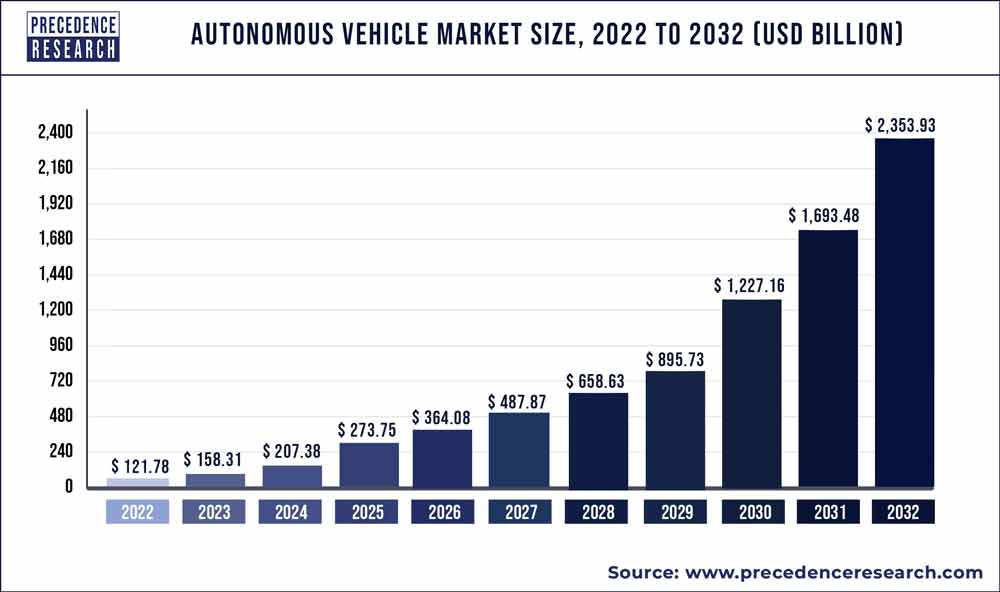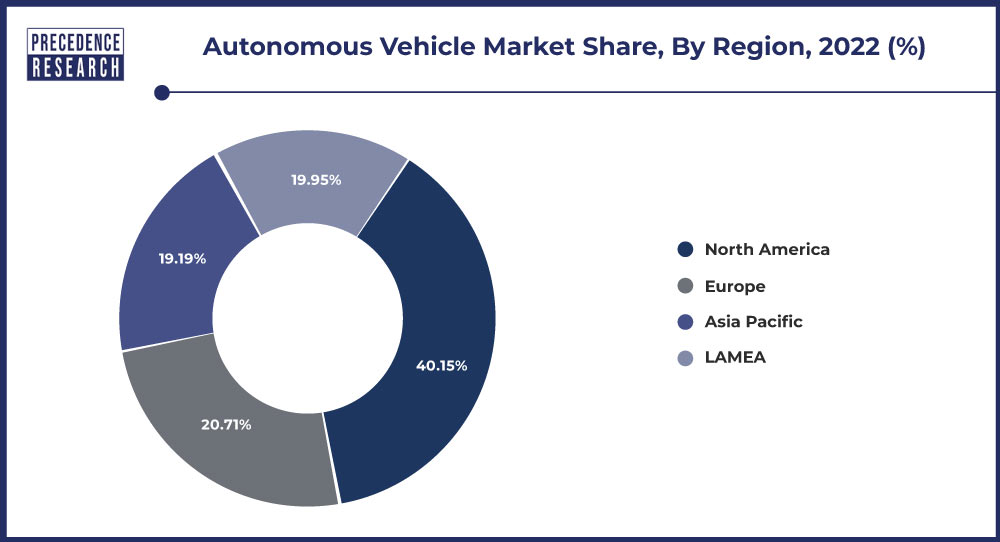The global autonomous vehicle market size surpassed USD 121.78 billion in 2022 and is expected to hit around USD 2,353.93 billion by 2032, poised to grow at a CAGR of 35% from 2023 to 2032. The growth of the autonomous vehicle market is driven by several key factors. Technological advancements, particularly in artificial intelligence, sensor technology, and connectivity, have significantly improved the capabilities and safety of autonomous vehicles, leading to increased consumer trust and adoption. Additionally, regulatory support and initiatives promoting the development and deployment of autonomous vehicles have played a crucial role in fostering industry growth.

Moreover, the growing demand for safer, more efficient transportation solutions, coupled with the potential for cost savings and increased productivity, has spurred investment and innovation in the autonomous vehicle sector. Furthermore, partnerships and collaborations between automotive manufacturers, technology companies, and other stakeholders are facilitating the rapid advancement and commercialization of autonomous vehicle technology, further fueling market expansion.
Autonomous Vehicle Market Key Pointers
- In 2022, North America attained the largest revenue share of more than 40.15%.
- Application, with the highest revenue share of 93.74% in 2022, was the transportation sector.
- From 2023 to 2032, the Asia-Pacific area is projected to grow at a CAGR of 35.6%.
- In 2022, the passenger sector constituted 74.15% of the revenue share, broken down by vehicle type.
- The semi-autonomous vehicle category held 95.06% of the revenue share by propulsion type in 2022.
Get a Sample: https://www.precedenceresearch.com/sample/1074
Autonomous Vehicle Market Regional Stance
The surge in the adoption of hybrid and electric vehicles in North America has positioned the region as a global leader in 2022, with expectations of continued growth over the forecast period. This trend is primarily driven by changes in traffic regulations within the U.S., which now allow autonomous vehicles to operate on public roads. To facilitate fully autonomous transportation, the government is taking proactive steps to enhance road infrastructure.
The U.S. autonomous vehicle market has experienced significant growth from 2022 to 2032, largely due to regulatory amendments supporting autonomous mobility on public roads. Notably, the National Highway Traffic Safety Administration (NHTSA) paved the way for self-driving car testing in several states, including California, Nevada, Michigan, Florida, and Washington D.C., as early as 2013.

Conversely, Europe is anticipated to emerge as the most lucrative region for the autonomous car market in the coming years. This shift is attributed to changing consumer preferences favoring automated products and the increasing adoption of autonomous vehicles. In 2018, the U.K. Department of Transport introduced legislation permitting autonomous vehicles on any public road without the need for additional insurance or permits. Moreover, the establishment of centers for autonomous and connected vehicles in 2018 further underscores the region’s commitment to this technology. The UK government has demonstrated its dedication to autonomous vehicles by aiming to convert all vehicles on the road to autonomous ones by 2021 through necessary regulatory adjustments.
Looking at the projected revenue of the global autonomous vehicle market from 2022 to 2032, North America leads the way with substantial growth, reaching USD 981.59 billion by 2032. Europe follows, with revenues forecasted to reach USD 513.16 billion by 2032. Asia Pacific and LAMEA (Latin America, Middle East, and Africa) regions also show significant growth potential, with revenues projected to reach USD 473.14 billion and USD 386.04 billion, respectively, by 2032.
Read More Report: Vehicle-to-Grid Technology Market Size Projected to Reach USD 45.09 Billion By 2033
Autonomous Vehicle Market Trends
- Growing Investment and Funding: There’s a surge in investment and funding in the Autonomous Vehicle sector, with both traditional automotive companies and tech giants pouring resources into research, development, and commercialization efforts. Venture capital firms are also actively investing in startups focused on autonomous vehicle technology, indicating confidence in the market’s growth potential.
- Expanding Applications: Autonomous vehicles are finding applications beyond passenger transportation, including logistics, delivery services, and agriculture. Companies are exploring the use of autonomous technology to optimize fleet operations, enhance supply chain efficiency, and increase productivity in various industries. Additionally, autonomous vehicles hold promise for improving mobility options for elderly and disabled individuals.
- Regulatory and Safety Challenges: As autonomous vehicles become more prevalent, regulatory frameworks and safety standards are evolving to ensure the safe deployment and operation of autonomous systems on public roads. Governments worldwide are grappling with issues such as liability, cybersecurity, and ethical considerations surrounding autonomous driving technology. Clear and standardized regulations are crucial for building consumer trust and facilitating widespread adoption.
- Partnerships and Collaborations: Collaboration is key to addressing the complex challenges associated with autonomous vehicle development. Automotive manufacturers, technology companies, and research institutions are forming partnerships to leverage complementary expertise and resources. Collaborative efforts aim to accelerate innovation, share best practices, and establish industry standards for autonomous driving technology.
Autonomous Vehicle Market Dynamics
Driver
The rising need for road safety is a crucial factor driving the growth of the autonomous vehicle market. With road traffic accidents posing a significant global challenge, there is increasing recognition of the potential of autonomous vehicles to enhance road safety through advanced sensing, computing, and decision-making capabilities. Autonomous vehicles utilize a combination of sensors, cameras, lidar, radar, and artificial intelligence algorithms to detect and respond to surrounding traffic conditions, pedestrians, and obstacles in real-time, thereby reducing the risk of accidents caused by human error. As governments, regulatory bodies, and stakeholders prioritize initiatives to improve road safety and reduce traffic fatalities, there is growing investment in autonomous vehicle technology as a means to mitigate road accidents and save lives.
Moreover, as the adoption of autonomous vehicles expands, there is potential for transformative changes in transportation systems, including reduced congestion, improved traffic flow, and enhanced mobility access for all road users. This trend underscores the critical role of autonomous vehicles in addressing road safety challenges and advancing the future of transportation towards safer, more efficient, and sustainable mobility solutions.
Restraint
There is a growing emphasis on vehicle platooning within the autonomous vehicle market. Vehicle platooning involves a convoy of vehicles traveling closely together, enabled by advanced communication and control systems that allow them to synchronize their movements. This approach offers several potential benefits, including improved traffic flow, reduced fuel consumption, and enhanced safety through coordinated driving behavior.
Moreover, vehicle platooning has the potential to increase the efficiency and scalability of autonomous vehicle deployment by leveraging cooperative driving strategies. As technology continues to evolve and regulatory frameworks evolve to accommodate platooning systems, stakeholders in the autonomous vehicle market are increasingly focusing on developing and implementing vehicle platooning solutions to realize these benefits and accelerate the adoption of autonomous driving technologies.
Opportunity
Vehicle safety and cybersecurity concerns are paramount in the autonomous vehicle market, shaping regulatory frameworks, technological advancements, and consumer perceptions. As autonomous vehicles become increasingly prevalent on roads, ensuring the safety of passengers, pedestrians, and other road users is a top priority for manufacturers, regulators, and policymakers. Safety concerns encompass various aspects such as collision avoidance systems, emergency braking, pedestrian detection, and vehicle-to-vehicle communication, all aimed at mitigating the risk of accidents and minimizing potential harm.
Furthermore, the integration of complex software systems and connectivity features in autonomous vehicles introduces cybersecurity vulnerabilities, raising concerns about potential cyber threats, data privacy breaches, and malicious attacks. Safeguarding autonomous vehicles against cyber threats requires robust cybersecurity measures, including encryption, intrusion detection systems, secure communication protocols, and regular software updates.
Addressing vehicle safety and cybersecurity concerns is essential to building trust and acceptance of autonomous vehicles among consumers and stakeholders. Manufacturers and technology providers must invest in rigorous testing, validation, and certification processes to ensure the reliability and resilience of autonomous systems. Additionally, collaboration between industry, government agencies, and cybersecurity experts is crucial to developing comprehensive strategies for managing risks and safeguarding the future of autonomous transportation.
Leading Companies in the Autonomous Vehicle Market
- BMW AG
- Audi AG
- Ford Motor Company
- Daimler AG
- Google LLC
- General Motors Company
- Nissan Motor Company
- Honda Motor Co., Ltd.
- Toyota Motor Corporation
- Tesla
- Volvo Car Corporation
- Uber Technologies, Inc.
- Volkswagen AG
Market Segmentation
By Application
- Defense
- Transportation
- Commercial transportation
- Industrial transportation
By Level of Automation
- Level 1
- Level 2
- Level 3
- Level 4
- Level 5
By Propulsion Type
- Semi-autonomous
- Fully Autonomous
By Vehicle Type
- Passenger Car
- Commercial Vehicle
By Regional Outlook
- North America
- U.S.
- Canada
- Europe
- U.K.
- Germany
- France
- Asia Pacific
- China
- India
- Japan
- South Korea
- Rest of the World
Immediate Delivery Available | Buy This Premium Research Report@ https://www.precedenceresearch.com/checkout/1074
